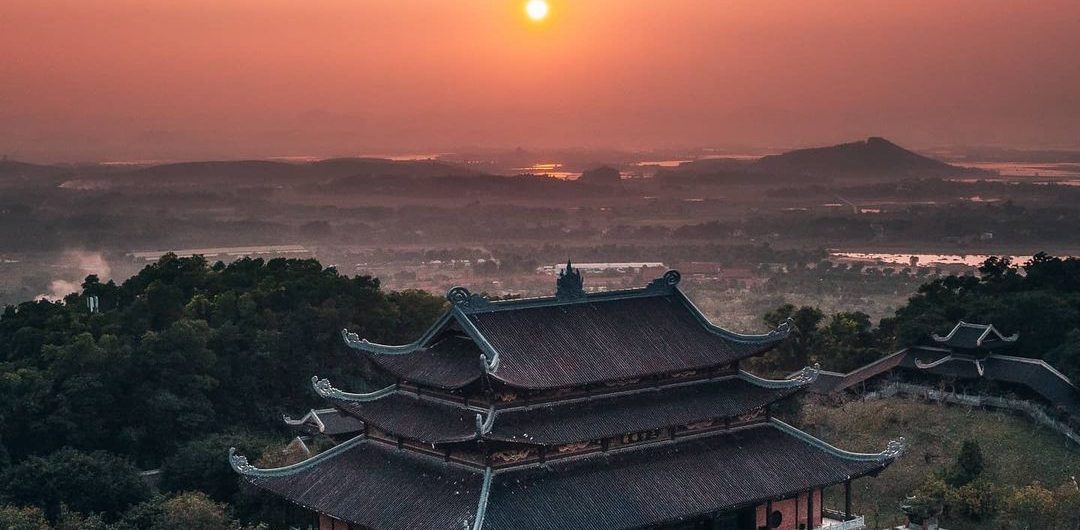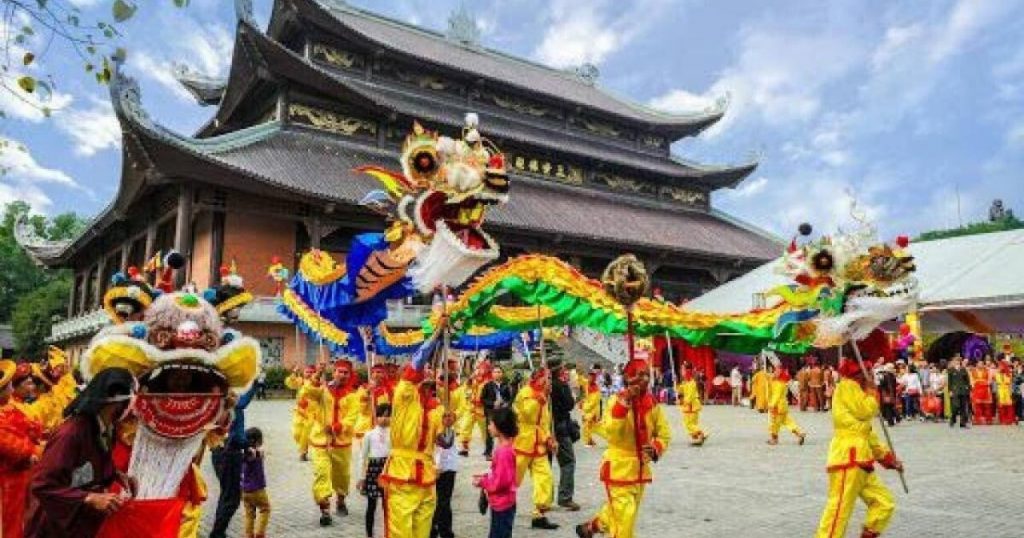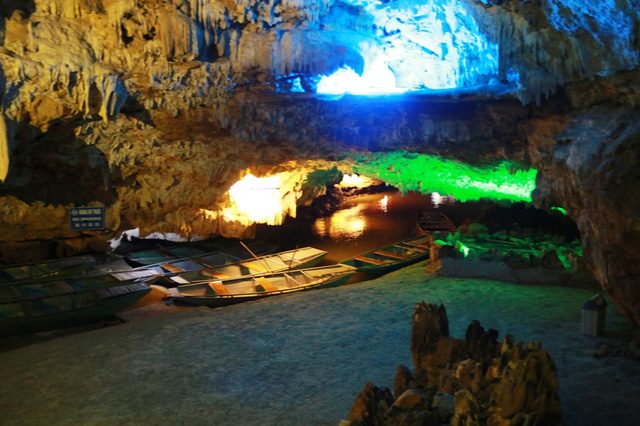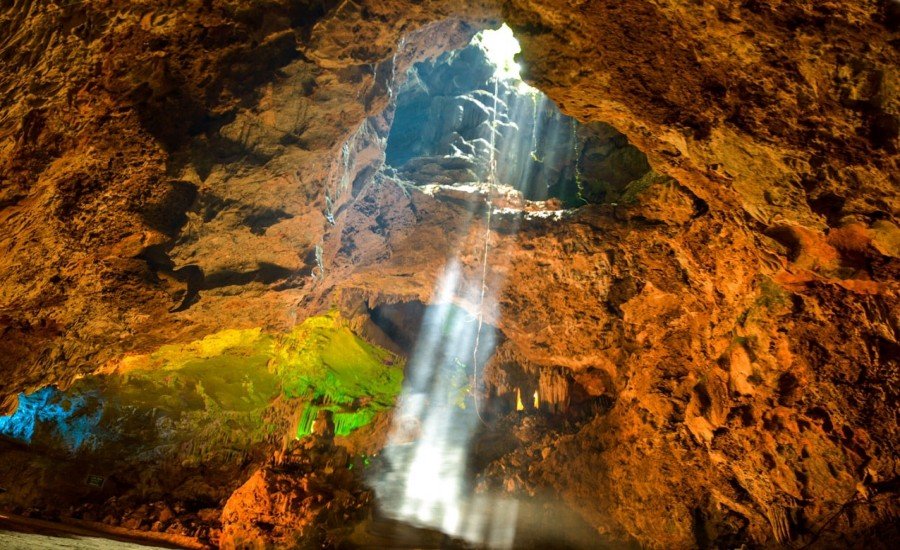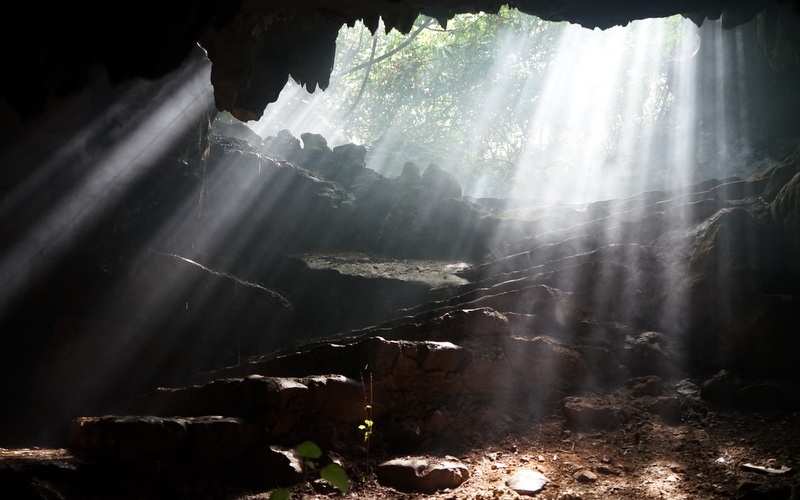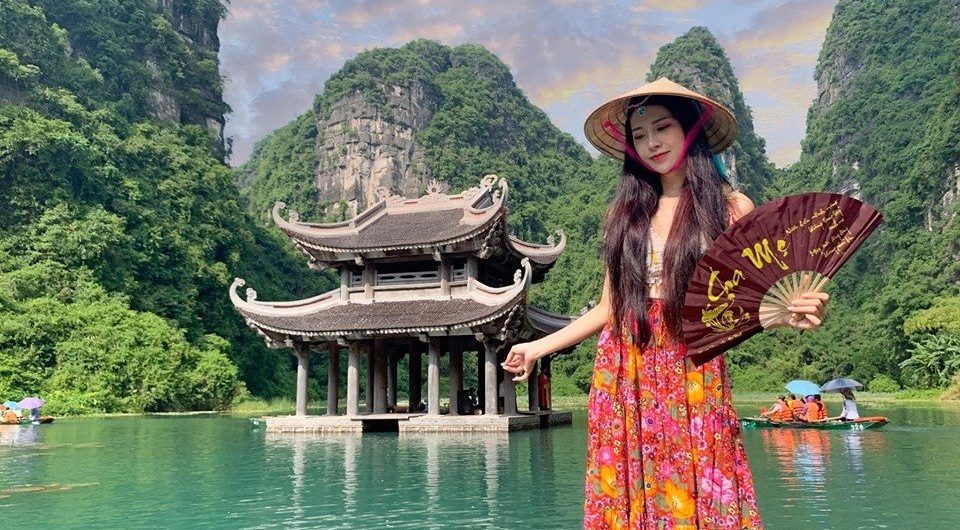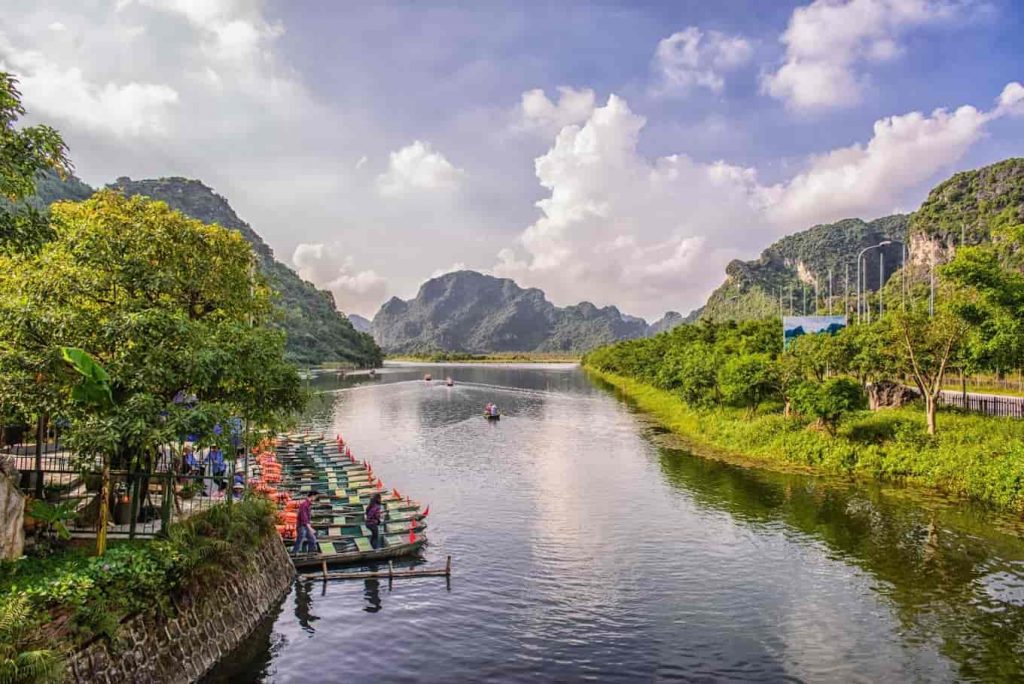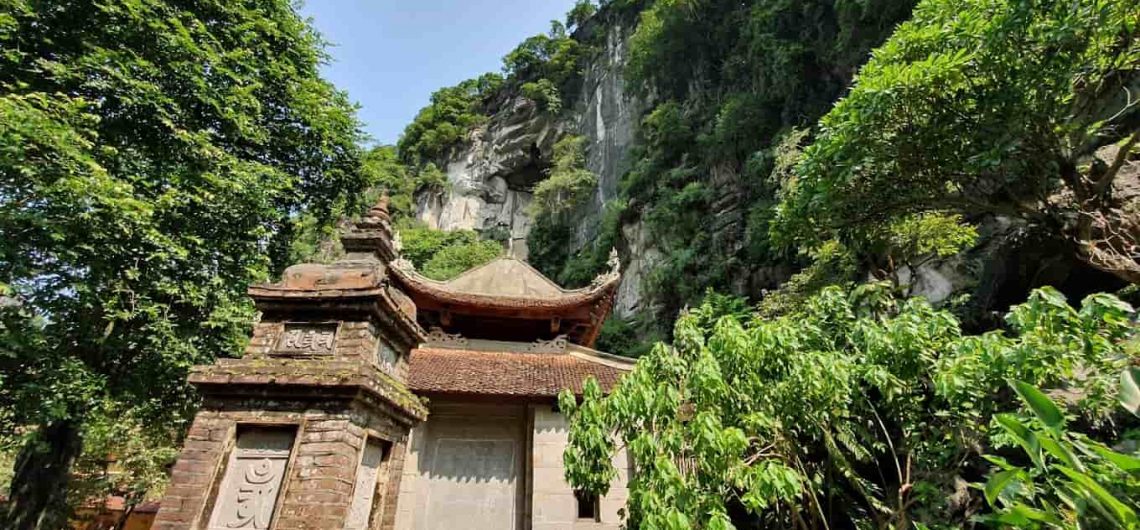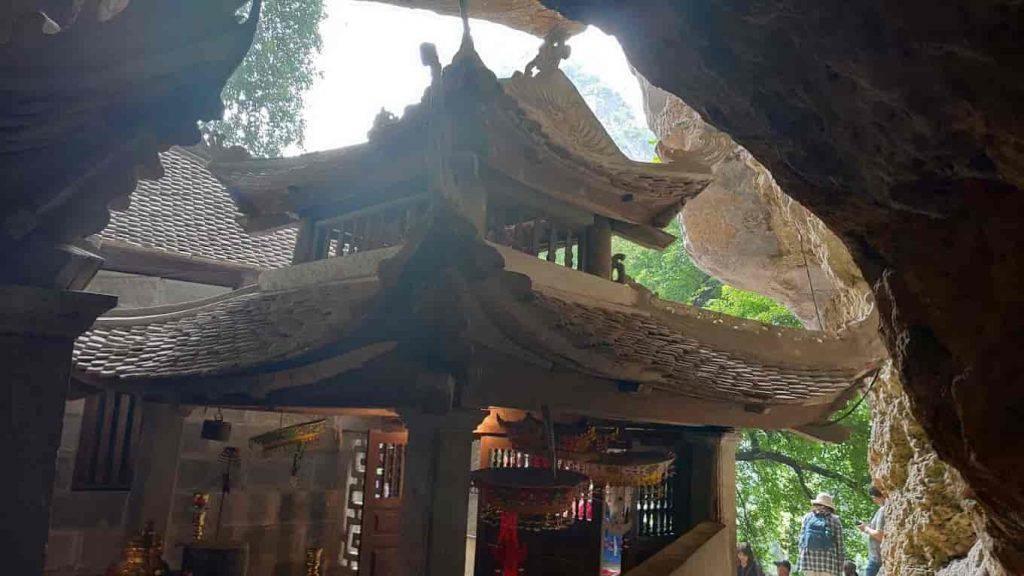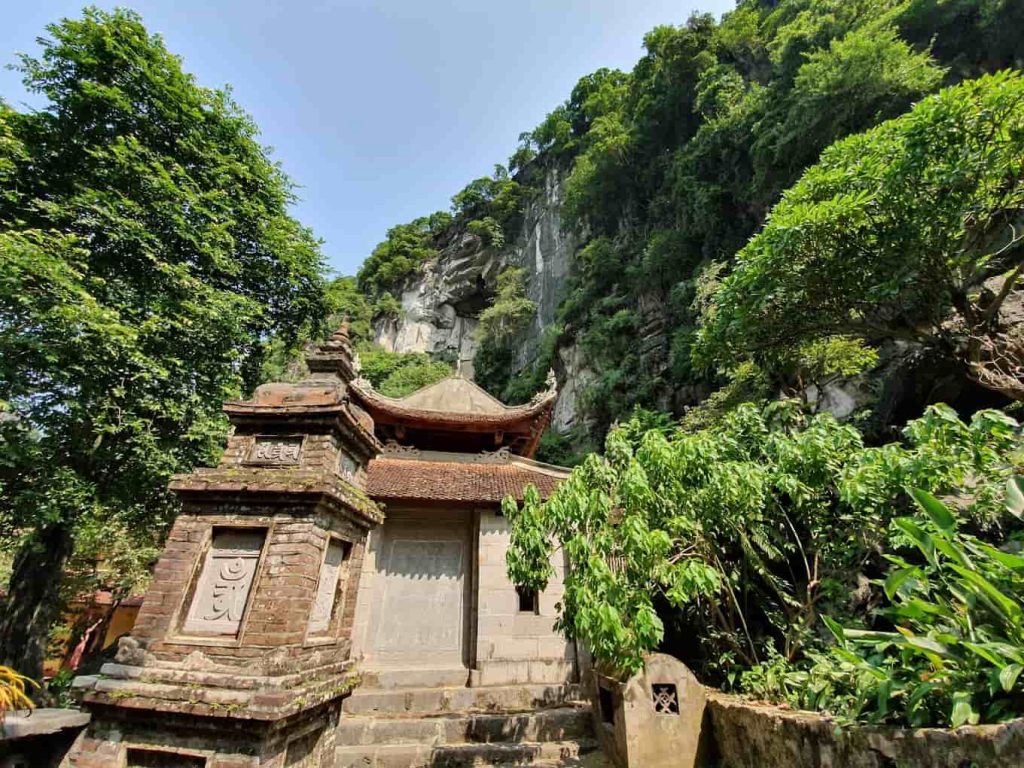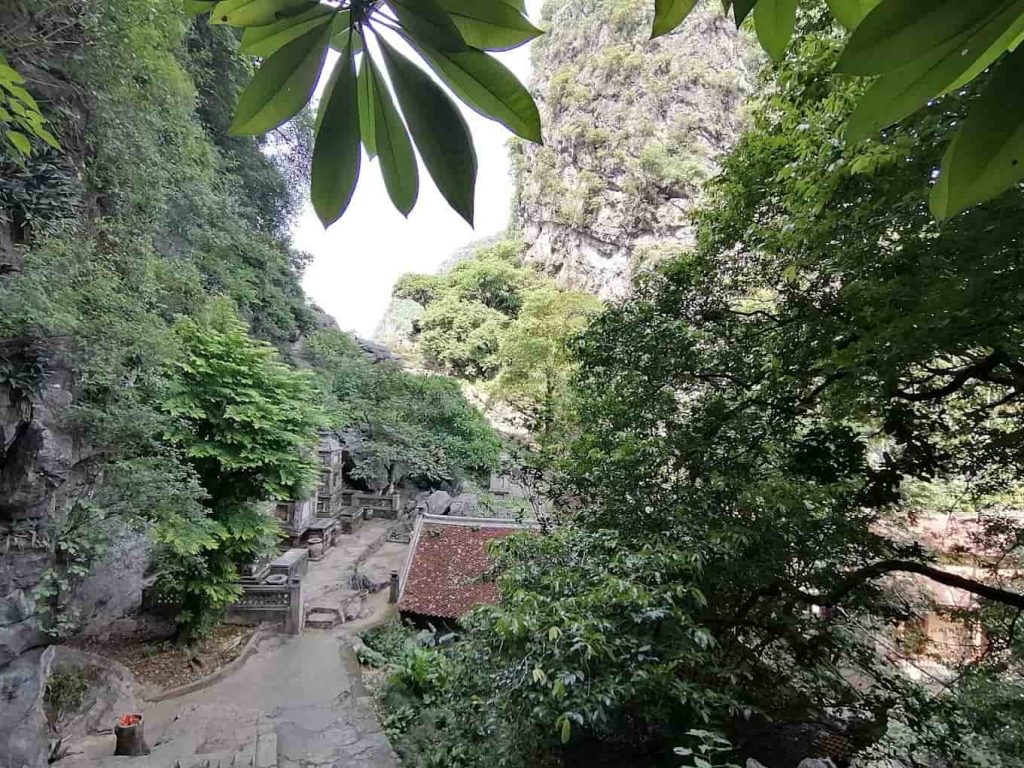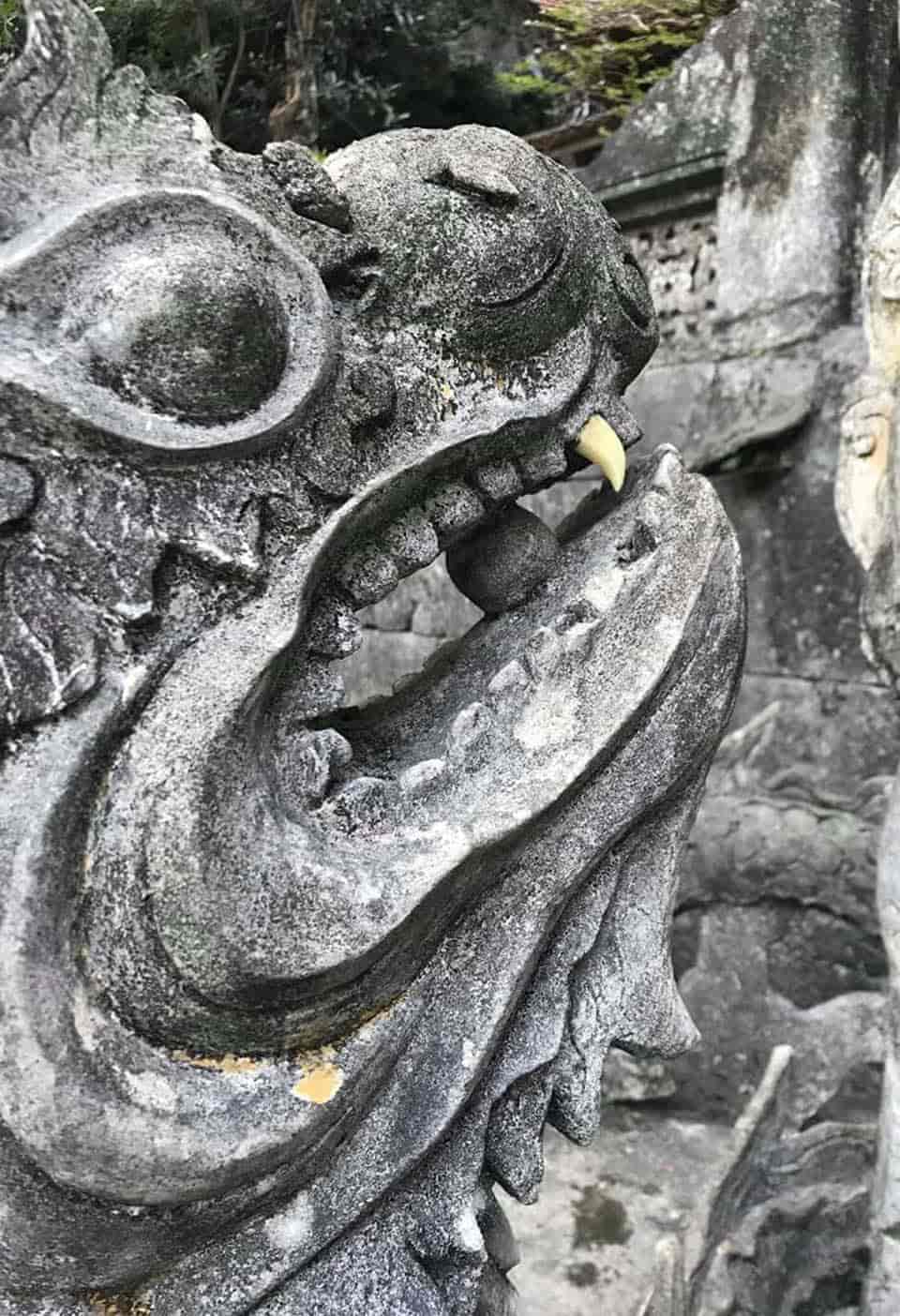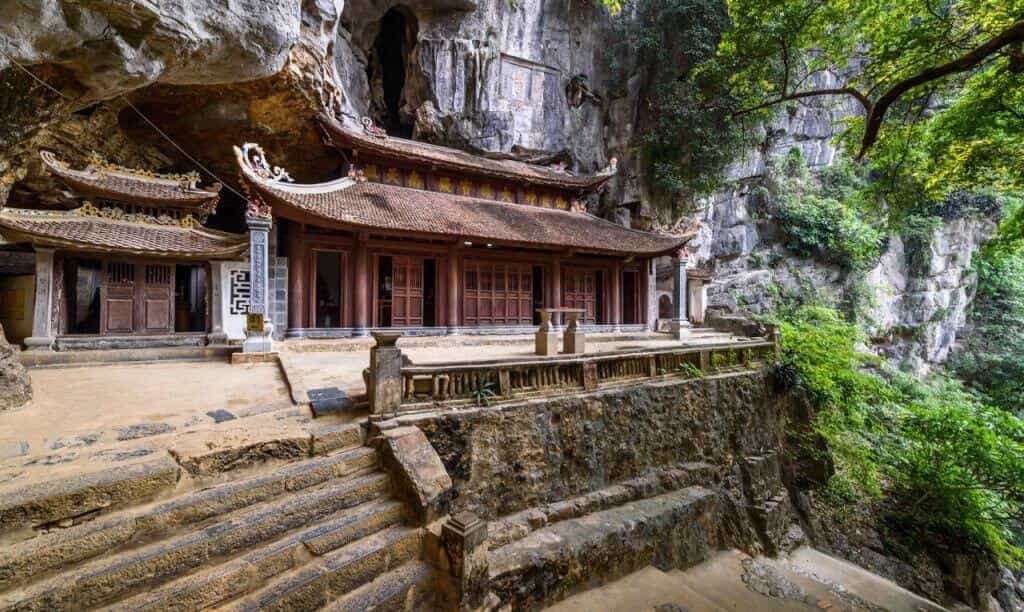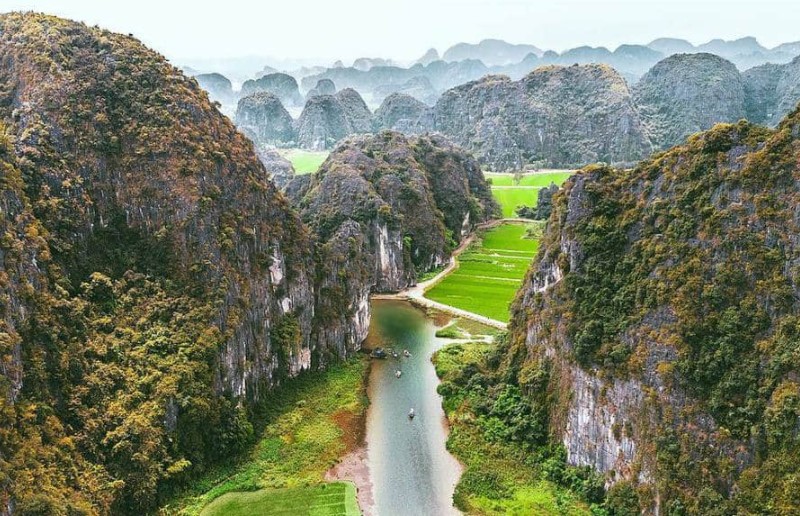Trang An – Bai Dinh are two frequently visited destinations together on a journey to Ninh Binh. While Trang An Ecotourism Area boasts majestic rivers, mountains, and timeless beauty that momentarily helps travelers forget their daily worries and the hustle and bustle of urban life, Bai Dinh Pagoda in Ninh Binh offers a sense of peace, tranquility, and serenity, typical of Buddhist land. This article provides an overview of the attractions of Bai Dinh Pagoda and shares experiences, tips, and considerations for visiting the temple.
Introduction to Bai Dinh Pagoda in Ninh Binh.
History of Bai Dinh Pagoda.
Introduction to Bai Dinh Pagoda – Over 1,000 years ago, the cultural and spiritual tourism area of Bai Dinh Pagoda in Ninh Binh was a temporary residence of the Dinh Dynasty. During the Ly Dynasty, the National Teacher Nguyen Minh Khong built the temple for meditation and as a place to provide healing remedies, especially for curing diseases of King Ly Than Tong.

Since ancient times, the temple has been a center for Buddhism (worshiping Buddha), Taoism (worshiping the Cao Son deity), and the Mother Goddess belief (worshiping Mau Lieu Hanh). To this day, various temples and shrines have been restored, including 21 main items, with two temples: the ancient Bai Dinh Pagoda and the new Bai Dinh Pagoda.
Who is the abbot of Bai Dinh Pagoda?
The abbot of the temple is Venerable Thich Thanh Nhieu, the Deputy Permanent Chairman of the Council of the Vietnam Buddhist Sangha, and he is also the abbot of Tam Chuc Pagoda (Ha Nam).
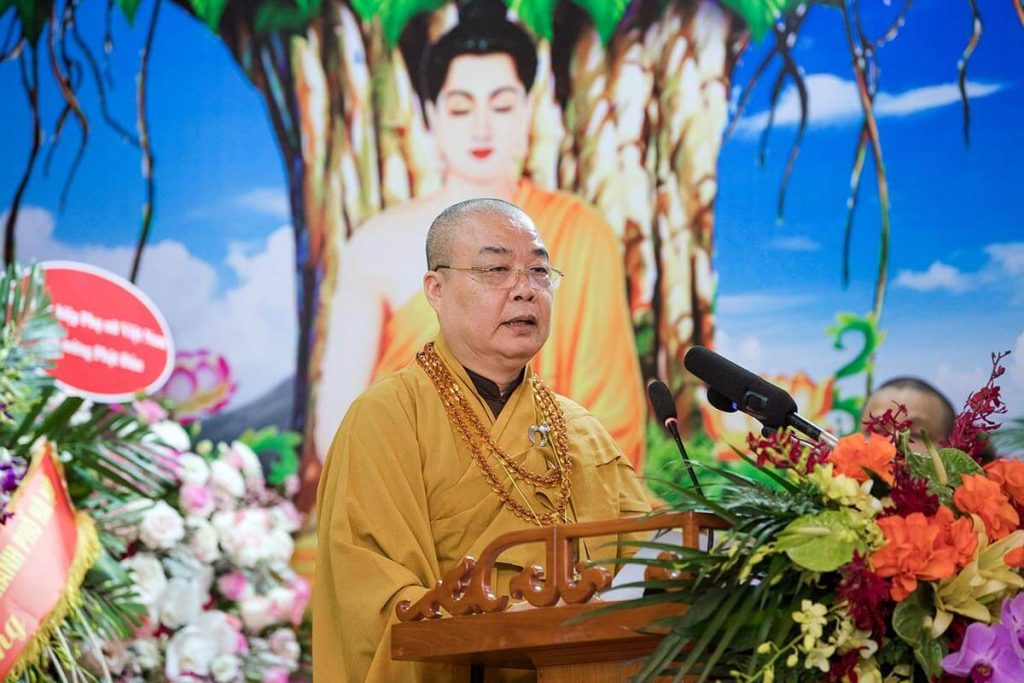
The deputy abbot of the temple is Most Venerable Thich Minh Quang, Deputy Head of the Central Office of the Vietnam Buddhist Sangha in Hanoi, and he is also the deputy abbot of Tam Chuc Pagoda (Ha Nam).
Where is Bai Dinh Pagoda located?
- Address: Located in Gia Sinh commune, Gia Vien district, Ninh Binh province.
The cultural and spiritual tourism area of Bai Dinh Pagoda in Ninh Binh is part of the Trang An Scenic Landscape Complex, located in Gia Sinh commune, Gia Vien district, Ninh Binh province, 7 km from the ancient capital of Hoa Lu and 15 km from Ninh Binh city.
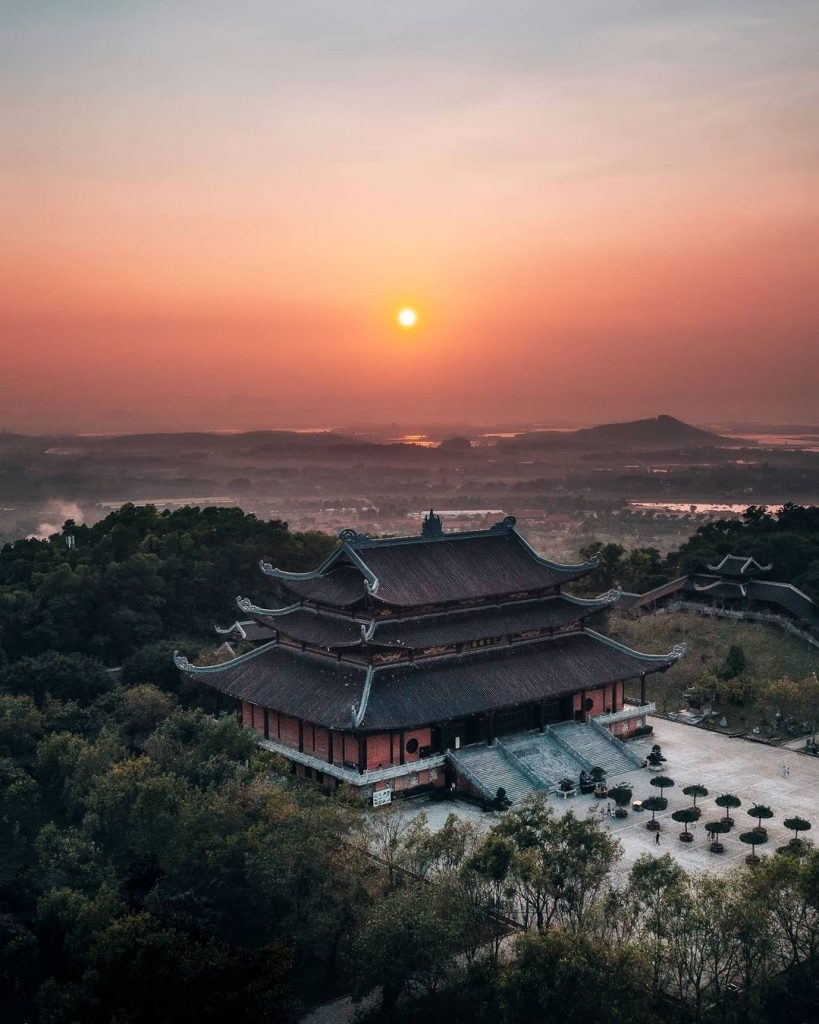
Bai Dinh Mountain is the starting point of the Hoa Lu limestone karst formation in the northwest and is also the foothill of the Himalayan range, where Buddhism originated. The mountains in the karst formation have an average height ranging from 70-170 meters.
With a height of 187 meters, Bai Dinh Mountain is the tallest peak in the region and is also known as the “master mountain” or “lord mountain” of the Hoa Lu limestone karst formation. Bai Dinh Mountain, according to popular interpretation, means “mountain with a worship ceremony on the summit.”
Area of Bai Dinh Pagoda.
The spiritual tourism area of Bai Dinh Pagoda covers a total of 539 hectares (the ancient Bai Dinh Pagoda occupies 27 hectares, while the new Bai Dinh Pagoda covers 80 hectares).
What are the suitable means of transportation to reach Bai Dinh Pagoda?
Located approximately 96 kilometers south of Hanoi’s city center, you can easily travel to Bai Dinh Pagoda using various means of transportation, including buses, motorcycles, or trains.
Visiting Bai Dinh Pagoda by Car
Currently, from Giap Bat Bus Station or My Dinh Bus Station in Hanoi, you can take buses heading to Ninh Binh to reach Bai Dinh Pagoda. The ticket prices for each trip range from 70,000 VND to 80,000 VND per person. After arriving at Ninh Binh Bus Station, you can continue your journey by taxi or bus to reach Bai Dinh Pagoda.
Alternatively, if you’re traveling in a group or with family, you can book a private car with a driver in Hanoi. With DanangPrivateCar.com’s private car service, you will enjoy comfort, safety, and the basic English-speaking skills of our professional drivers. They will pick you up anywhere in Hanoi, and since it’s a private car, your itinerary can be tailored to your preferences. You can stop wherever you like along the way. Book a private car from Hanoi to Ninh Binh today to explore Bai Dinh Pagoda.
Motorcycle.
If you want to save on transportation costs and have more flexibility with your travel schedule, a motorcycle is the perfect choice for you. When traveling by motorcycle, you can take National Highway 1A to the central area of Ninh Binh City, and then follow the signs to reach the pagoda.
Train.
Trains are an excellent choice for your Ninh Binh exploration journey if you have more time to spare. You can catch a train at Hanoi Railway Station and arrive at Ninh Binh Railway Station. From there, you can take a bus or a taxi to reach Bai Dinh Pagoda. The ticket prices for a train journey vary, with seats costing around 120,000 VND depending on the seating class.
Bai Dinh Pagoda Map.
To reach and visit Bai Dinh Pagoda, you can use Google Maps to find directions. This is a very famous spiritual tourism area, so the roads are very convenient, and the information is clear. The local residents are all familiar with it, so you have multiple ways to find your way to the temple.
Map of Bai Dinh Pagoda Tour

Ticket Prices for Electric Cars and Sightseeing at Bai Dinh Pagoda.
| Service | Price |
| Tram tickets | 60,000 VND/person |
| Tickets to visit the Stupa | 50,000 VND/person |
| Tour guide ticket price | 300,000 VND/tour |
- Electric Car Ticket: 60,000 VND per person.
- Bao Thap Sightseeing Ticket: 50,000 VND per person.
- Tour Guide Fee: 300,000 VND per tour.
Bai Dinh Festival.
Every year on the 6th day of the lunar calendar (the 6th day of Tet Nguyen Dan), Bai Dinh Pagoda holds a festival known as the Bai Dinh Pagoda Festival. However, due to the COVID-19 pandemic, the festival was not held in 2020 and 2021.
Tips for Visiting Bai Dinh Pagoda.
When is the best time to visit Bai Dinh Pagoda Trang An?
If you want to enjoy the festive atmosphere and the lively crowd of people traveling for the Lunar New Year, you can choose to visit the pagoda from January to March of the lunar calendar.
This is also a time when the spring weather is warm and pleasant, making it a beautiful time for pilgrimages and New Year’s celebrations at Bai Dinh Trang An. You can combine sightseeing, temple visits for blessings, and participation in festivals in Trang An and Bai Dinh.
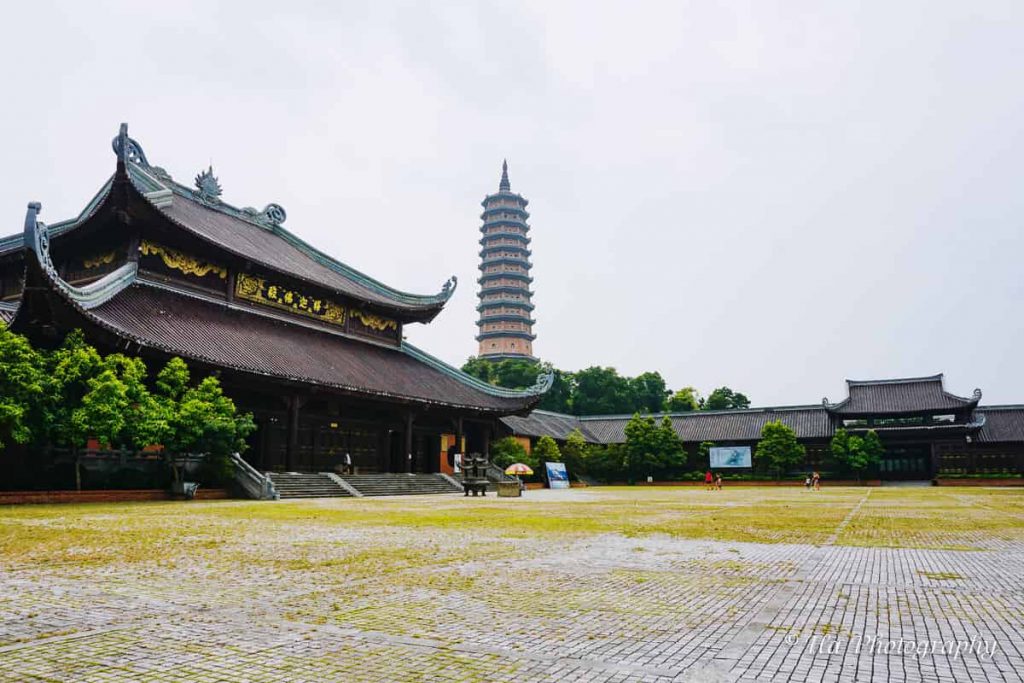
If the Trang An Festival takes place from the 17th to the 21st day of the lunar calendar, the Bai Dinh Pagoda Festival is held on the first day of the Lunar New Year, the 6th day of the first lunar month.
With experience visiting Bai Dinh Pagoda, I would advise you to note that this is a peak festival tourism season, so there can be large crowds and sometimes overcrowding.
Therefore, if you want to enjoy tranquility, you can visit the pagoda and Trang An at other times of the year. Each season brings its unique beauty to Bai Dinh – Trang An, but the most charming atmosphere is often during the autumn season.
What to Prepare and Consider When Visiting Bai Dinh Pagoda?
When visiting and sightseeing at the temple, please wear modest and respectful attire. Avoid lighting too many incense sticks and dispose of trash in designated areas. During the New Year period, when pilgrims are numerous, take proactive measures to safeguard your personal belongings and avoid losing them.
Regarding clothing: The temple grounds are extensive, and visitors may need to walk and climb hills. Therefore, it’s advisable to wear comfortable sports shoes with flat rubber soles rather than high heels to protect your feet and facilitate movement.
Clothing for temple visits should be modest and respectful. If you wear outfits for taking photos or check-ins, make sure to cover up with fabric or Buddhist attire before entering the temple.
During the early spring, there may be light drizzles, so it’s a good idea to bring an umbrella. In the summer, you should have sun protection accessories like long-sleeved shirts, hats, sunglasses, and water. In the winter, dress warmly.
Remember to carry small denominations of money if you wish to make merit or donate to the temple. Avoid placing money on Buddha statues as it disrupts the temple’s aesthetic; instead, use donation boxes.
Regarding offerings: Temple rituals are about sincerity and practical kindness in daily life. Therefore, prepare temple offerings thoughtfully, neatly, without extravagance. Special attention should be paid to vegetarian offerings such as fruits, cakes, water, and incense.
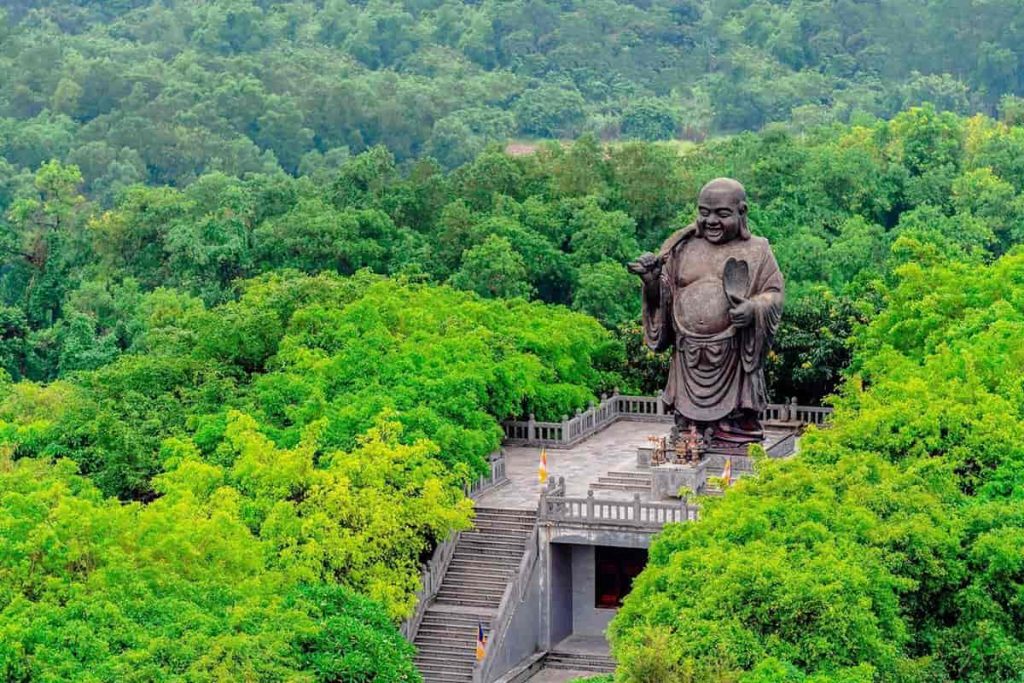
Accommodation at Bai Dinh Guesthouse.
Bai Dinh Guesthouse is situated within the temple grounds and is constructed with ancient and elegant architecture, exuding a distinctive classical Eastern charm.
Nestled amidst the tranquil and majestic natural surroundings of mountains and hills, Bai Dinh Guesthouse is an ideal place for international travelers to relax, hold meetings, and visit Bai Dinh Pagoda.
Bai Dinh Guesthouse is designed with earthy-toned materials, evoking a sense of serenity, and its interior is crafted from rare and precious woods. Stepping into this place feels like entering a world of tranquility and absolute relaxation.
Staying here, you will feel the weariness and troubles of modern life dissipate in an instant, immersing yourself in the pure beauty of nature, occasionally hearing the echoing sound of temple bells.
If you prefer not to venture far from other tourist destinations in Ninh Binh province, you can consider staying in some homestays near Trang An or in the city center of Ninh Binh.
The quickest way is to book a room on Agoda, where you have numerous options to choose from, including hotels, homestays, resorts, Bai Dinh Guesthouse, and more.
Bai Dinh Ancient Pagoda.
The Jade Well.
The Jade Well covers an area of about 6,000 square meters with a diameter of 30 meters and a depth of 10 meters. The water level is around 6-7 meters, and the well is surrounded by four octagonal tiers. The water in the well has a beautiful jade-green color, and the natural spring has never run dry despite its high elevation location.
The Three-Gate Entrance of Bai Dinh Pagoda.
During your journey to Bai Dinh Pagoda in Ninh Binh, you will pass through the Three-Gate Entrance, which is inscribed with four Chinese characters that read “Minh đỉnh danh lam.” According to tradition, these four characters were presented by King Le Thanh Tong (1460-1496) and are part of a four-line poem written in Chinese characters.
“Minh đỉnh danh lam” translates to “This is a very beautiful and valuable Buddhist temple, deserving to be inscribed on the peak for everyone to know.”
The cave dedicated to Lord Buddha
The cave dedicated to Lord Buddha, also known as Hang Sang, is approximately 25m long and 15m wide. This is the temple dedicated to Lord Buddha, established by Venerable Nguyen Minh Khong around the years 1096 – 1106. In front of the cave, there are two Deities: Mr. Khuyen Thien and Mr. Trung Ac. Inside the cave is the main shrine, known as the Three Treasures Hall, which worships the three Buddhas representing the past, the present, and the future. On the right-hand side, there is the Holy Virtuous Deity, and on the left-hand side, there is the Lord Deity.
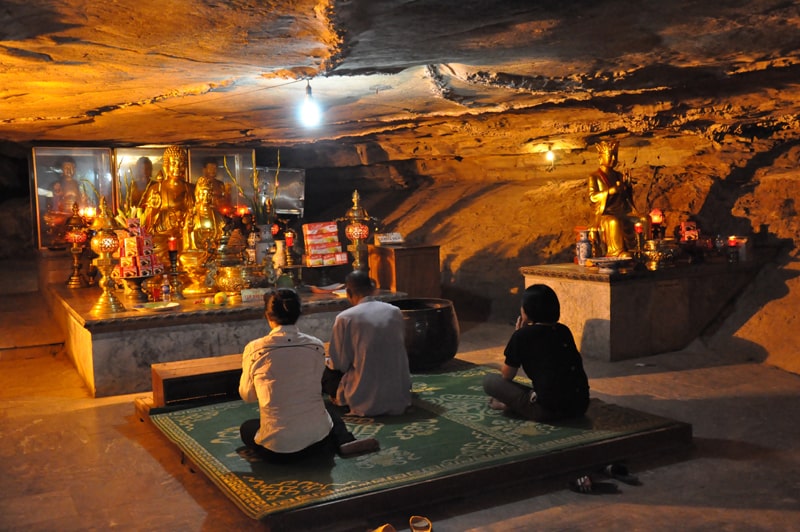
Currently, all the statues worshipped here are cast from solid bronze and coated with gold. It can be said that this space is both sacred and pure, a place where Buddhists and sentient beings can most clearly feel the holiness and transcendence of the Buddhist realm.
The Shrine of Cao Son Deity.
Moving deeper into the Sang Cave, behind the Buddha altar, you will find the shrine of Cao Son Deity. According to the legend, Cao Son Deity was Lac Vuong Vu Lam, the 17th son of King Lac Long Quan. He was a deity who taught and helped the people with their livelihoods and businesses, which is why a shrine was erected in his honor.
Cao Son Deity, along with Thien Ton Deity and Quy Minh Deity, are three deities guarding the western, eastern, and southern gateways of the ancient capital Hoa Lu. The current shrine of Cao Son Deity has an architecture similar to Thanh Nguyen Shrine, with its back against the mountain and a corridor separating it from the valley in front.
The Medicinal Garden in Front of the Shrine of Cao Son Deity.
It is believed that this is the medicinal garden where the Zen Master Nguyen Minh Khong cultivated medicinal plants for the local people. It was named Sinh Duoc, meaning “the garden of life” or “natural medicinal garden,” in contrast to processed and commercialized medicines.
Later, many traditional medicine practitioners came here to find medicinal plants for treating illnesses and saving lives. The garden covers an area of about 4 hectares and contains valuable medicinal plants such as ginseng, hoai son, sam bo chinh, ngu da bi, don xuong, dang sam, and more.
The Shrine of Saint Nguyen Minh Khong.
This shrine is located in the center of the “arm’s embrace” of Bai Dinh Mountain. On one side, it worships Buddha and Cao Son Deity, while on the other side, it worships the Mother Goddess.
National Teacher Nguyen Minh Khong, also known as Nguyen Chi Thanh, was born in 1066 in Diem Duong village (now Gia Thang commune, Gia Vien district). He entered monastic life at the age of 11 and became blood brothers with Tu Dao Hanh and Nguyen Giac Hai. He is considered a divine healer who used Southern medicine to cure King Ly Thanh Tong of an “incurable” illness. He was one of the first to discover the use of Southern medicine for healing. He passed away in 1141 at the age of 76.
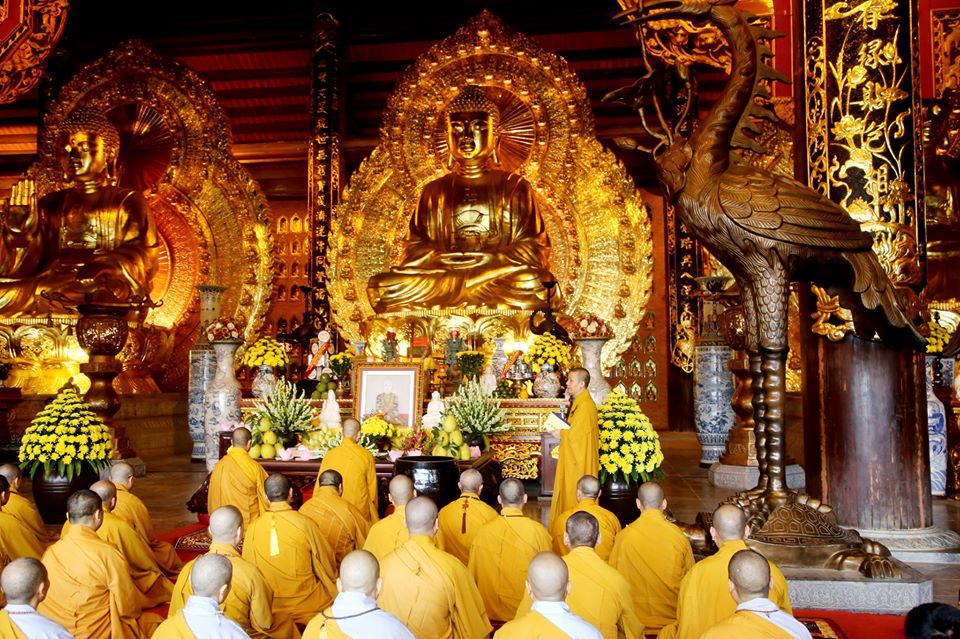
Nguyen Minh Khong is also known as the founder of bronze casting and is credited with creating the famous “four great sacred objects” of the Ly Dynasty: Bao Thien Tower, Quy Dien Bell, Quynh Lam Statue, and Pho Minh Vase.
Today, he is worshipped in many places across Vietnam, and his name is closely associated with the Sinh Duoc Garden in Bai Dinh Mountain. Legends and miracles related to Saint Nguyen Minh Khong are abundant in the Bai Dinh Pagoda area and its surrounding regions.
The Shrine of the Mother Goddess.
This cave is also known as the Dark Cave or the Shrine of the Mother Goddess. Inside the cave, there are seven small interconnected caves. In the middle of the cave, there is a rock formation that hangs down like a pillar, known as the “pillar supporting the heavens.” When struck, it produces enchanting sounds like a musical instrument.
The worship of the Mother Goddess in this cave follows the indigenous beliefs of the Vietnamese people. The Dark Cave is dedicated to the Holy Mother Lieu Hanh, a deity who is both a saint and a human. She is the Mother of the universe, known for her “three births and three transformations.”
Inside the Dark Cave, there is also a “path to heaven” and a “path to the underworld.”
The Fairy Pond.
Inside the cave dedicated to the Mother Goddess, there is a small pond known as the Fairy Pond. This pond is considered a place of gathering blessings because it forms naturally, with water flowing from small rocks year-round, so the Fairy Pond never runs dry.
Bai Dinh New Pagoda.
In 2003, based on the foundation of the old temple, the Xuân Trường Construction Company undertook the restoration and construction of the new Bai Dinh Pagoda. Currently, the pagoda comprises 8 main construction items: the Three-Gate Entrance, the Arhat Corridor, the Bell Tower, the Quan The Am Bodhisattva Temple, the Phap Chu Temple, the Tam The Temple, the Phat Di Lac Statue, and the Bao Thap Pagoda. It holds several records confirmed by the Vietnam Record Center, including:
- The largest bronze bell in Vietnam (weighing 36 tons, 18.25 meters tall).
- The tallest and heaviest bronze statue of Lord Buddha Shakyamuni in Vietnam (weighing 100 tons, 10 meters tall).
- The largest bronze statues of the Three Buddhas in Vietnam (each weighing 50 tons, 7.2 meters tall).
- The largest Water Well in Vietnam (with a diameter of 30 meters).
- The largest bronze statue of Goddess Quan The Am in Vietnam (weighing 80 tons, 5.4 meters tall).
- The largest collection of 500 Arhat statues in Vietnam.
- The most Bodhi trees in Vietnam.
- The heaviest bronze Eight Precious Statues in Vietnam (each weighing 4 tons, 3.95 meters tall).
- The tallest and heaviest bronze statues of Lord Khuyen Thien and Lord Tru Ac in Vietnam (each weighing 20 tons, 5.2 meters tall).
- The largest wooden altars in Vietnam.
- The largest bronze crane pair in Vietnam.
- The largest bronze statue of Phat Di Lac in Southeast Asia (weighing 80 tons, 10 meters tall).
- The tallest tower in Asia (the highest Buddhist tower in Asia), standing at 99 meters tall with 13 floors.
In addition, the pagoda continues to build other facilities such as the Cultural Park and the Buddhist Academy, the Dam Thi Lake area, and more.
Bai Dinh Temple Three-Gate Entrance.
The Three-Gate Entrance consists of three doors, following Buddhist teachings: Khong quan, Trung quan, and Gia quan, which also mean emptiness, impermanence, and no-self. The Three-Gate Entrance is entirely constructed from wood, using approximately 550 tons of round timber. It features stacked architecture, standing 16.5 meters tall, 13 meters wide, and 32 meters long.
In front of the Three-Gate Entrance, on both sides, there are two stone lions, symbolizing the strength of wisdom. Placing them in front of the entrance signifies controlling the pilgrims’ minds.

Upon entering the Three-Gate Entrance, you will find the Khuyen Thien deity on the right and the Trung Ac deity on the left.
Above the entrance, there’s a symbol of the wheel of reincarnation, carved in relief, representing the continuous cycle of Buddhist teachings, of heaven and earth.
In the center, there’s the word “Van,” symbolizing the eternal fire of wisdom. “Van” also represents the wisdom and great compassion of the Buddha. The “Van” symbol extends to both sides, signifying the infinite reach of the Buddha’s power, extending in all directions infinitely.
Arhat Corridor (Arhat Avenue).
Along both sides of the Arhat Corridor, there are 500 Arhat statues, crafted from stone by artisans from the Ninh Van stone village (Hoa Lu). That’s why it’s also known as Arhat Avenue.
Arhat Avenue consists of two rows, each with 117 chambers, totaling 526 meters in length.
Arhats are disciples of Lord Buddha Shakyamuni who have not yet attained Buddhahood, hence the term “Arhat.”
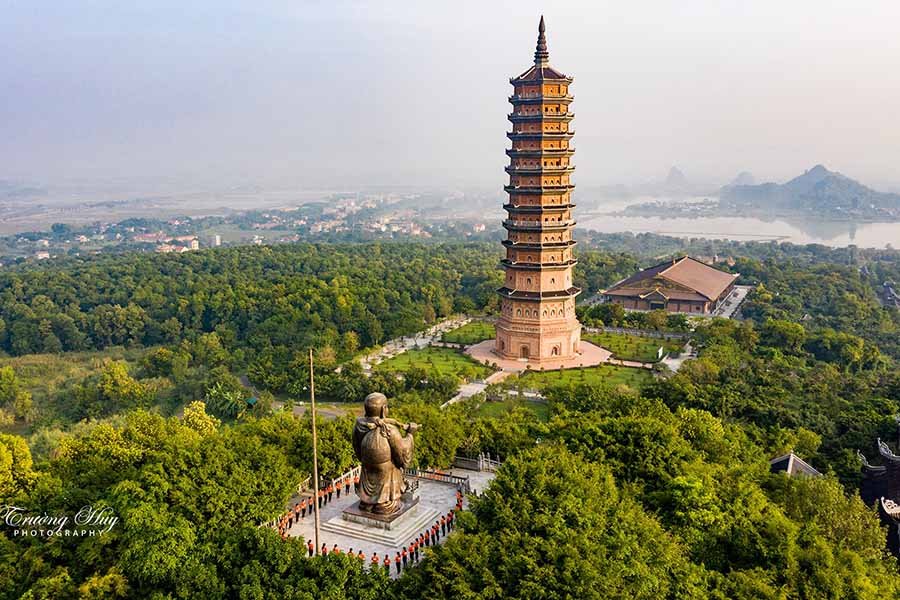
On both sides of this path, many jackfruit trees are planted. In Buddhist tradition, jackfruit represents Paramita, which means reaching the shore of enlightenment. The significance of the jackfruit tree is great enlightenment, the highest level of liberation. Therefore, jackfruit is considered sacred and is associated with Buddhism (jackfruit wood is used for temple doors and Buddha statues, while jackfruit leaves are used in Buddhist rituals).
Bell Tower of Bai Dinh Temple.
The bell tower has an octagonal architecture with three curved roofs, standing 18.25 meters tall with a diameter of 17 meters, resembling a lotus flower. The bell inside the bell tower weighs 36 tons and was cast by artisans from Hue. This bell has been confirmed by the Vietnam Record Center as the largest bronze bell in Vietnam.
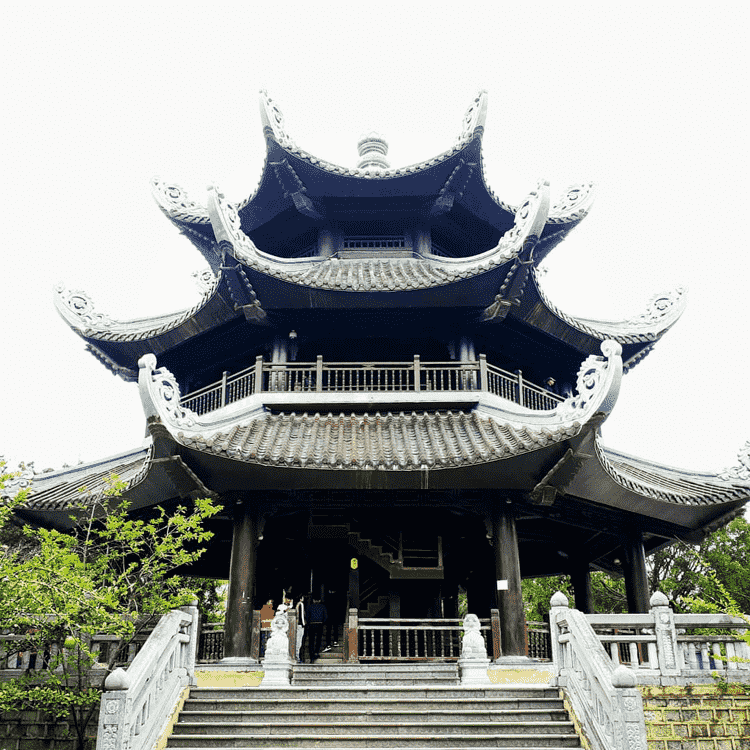
Quan The Am Bodhisattva Temple.
This structure is entirely made of wood, using approximately 900 cubic meters of round timber. The temple consists of 7 chambers, measuring 14.8 meters in height, 16.8 meters in width, and 40.4 meters in length.
The Quan The Am Bodhisattva statue is 5.4 meters tall, or 9.57 meters including the pedestal, and weighs 80 tons, or around 100 tons including the pedestal.
As we know, Quan The Am represents the Four Immeasurable Minds: loving-kindness, compassion, empathetic joy, and equanimity. Therefore, anywhere Quan The Am is found, it symbolizes compassion and the salvation of all beings.
On both sides of the Quan The Am statue with a thousand eyes and a thousand hands, there are statues representing compassion and wisdom. Both statues are made of wood, each 10 meters tall and weighing 4 tons.
Phap Chu Temple of Bai Dinh Temple.
In front of the Phap Chu Temple, there is a holy pond covering an area of about 5000 square meters, surrounded by numerous Bodhi trees. These trees were planted by various leaders and former heads of state during their visits to the temple.
Additionally, you can learn more about the Bodhi tree (Am Han Viet: Ba-la-mat-da), which signifies enlightenment. The Bodhi tree is a sacred tree associated with Buddhism, carrying elements of enlightenment. Therefore, it is placed outside the temple.
The Phap Chu Temple is constructed with 2 floors and 8 curved roofs, comprising 5 chambers. It is 30 meters in height, 44.7 meters in length, 43.3 meters in width, with a total area of 1945 square meters.
The Phap Chu statue is 10 meters tall, weighs 100 tons, and was cast by artisans from Y Yen, Nam Dinh.
To the right of the temple is the statue of Ananda, measuring 7.2 meters tall and weighing 30 tons of bronze. Ananda was known for his intelligence and wisdom, being one of Buddha’s direct disciples who heard many teachings from him. On the left is the statue of Mahakasyapa, also measuring 7.2 meters tall and weighing 30 tons of bronze. He was the first patriarch of Buddhist monastic discipline.
On both sides of the temple are the Eight Precious Statues, responsible for protecting the Buddhist teachings externally.
Tam The Temple of Bai Dinh Temple.
The Tam The Temple has a three-story curved roof architecture, comprising 7 chambers and 2 wings. It has a total of 66 concrete columns with wooden cladding. The temple stands at 34 meters in height, 59.10 meters in length, 40.50 meters in width, and the inner area covers 2364 square meters.
The stone relief in front of the Tam The Temple measures 10 meters by 10 meters and depicts the Four Dignities: dragon, lion, elephant, and peacock.
Inside the Tam The Temple, there are three bronze statues created by artisans from Y Yen (Nam Dinh). Each statue is 7.20 meters tall, weighs 50 tons, and is placed on a 1.5-meter-high stone pedestal.
Tam The represents the three times: past, present, and future. The significance of these statues is that the Buddhas of the three times continuously succeed each other to enlighten sentient beings.
The central Buddha statue represents the present, also known as the Virtuous Eon. The Buddha statue on the left represents the past, known as the Tranquil Eon. The Buddha statue on the right represents the future, known as the Wondrous Eon.
Phat Di Lac of Bai Dinh Pagoda.
The Phat Di Lac statue, standing 10 meters tall and weighing 80 tons, is located on a hill. Phat Di Lac is an absolute symbol of happiness in feng shui. It is believed that the smile of Phat Di Lac dispels sorrow and anger, bringing happiness to people. Phat Di Lac sometimes carries a lotus symbolizing health and longevity and a staff symbolizing authority.
Bai Dinh Pagoda is one of the spiritual landmarks cherished by many in the land of Ninh Binh. It is not only a place steeped in ancient stories from the early days of Buddhism’s arrival in our country but also home to countless significant structures and magnificent, picturesque scenery. If you have the opportunity to visit Ninh Binh in the early days of the new year, don’t miss the chance to explore Bai Dinh Pagoda.

